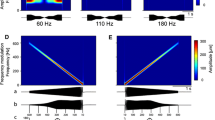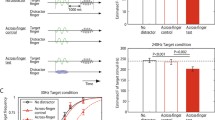Abstract
When rats acquire sensory information by actively moving their vibrissae, a neural code is manifested at different levels of the sensory system. Behavioral studies in tactile discrimination agree that rats can distinguish different roughness surfaces by whisking their vibrissae. The present study explores the existence of neural encoding in the afferent activity of one vibrissal nerve. Two neural encoding schemes based on “events” were proposed (cumulative event count and median inter-event time). The events were detected by using an event detection algorithm based on multiscale decomposition of the signal (Continuous Wavelet Transform). The encoding schemes were quantitatively evaluated through the maximum amount of information which was obtained by the Shannon’s mutual information formula. Moreover, the effect of difference distances between rat snout and swept surfaces on the information values was also studied. We found that roughness information was encoded by events of 0.8 ms duration in the cumulative event count and event of 1.0 to 1.6 ms duration in the median inter-event count. It was also observed that an extreme decrease of the distance between rat snout and swept surfaces significantly reduces the information values and the capacity to discriminate among the sweep situations.







Similar content being viewed by others
References
Albarracín, A. L., Farfán, F. D., Felice, C. J., & Décima, E. E. (2006). Texture discrimination and multi-unit recording in the rat vibrissal nerve. BMC Neuroscience, 7, 42.
Albarracín, A. L. (2008). Estudio fisiológico y anatómico del control motor de las vibrisas de la rata. PhD Thesis.
Arabzadeh, E., Panzeri, S., & Diamond, M. E. (2006). Deciphering the spike train of a sensory neuron: counts and temporal patterns in the rat whisker pathway. The Journal of Neuroscience, 26(36), 9216–9226.
Arabzadeh, E., Zorzin, E., & Diamond, M. E. (2005). Neuronal encoding of texture in the whisker sensory pathway. PLoS Biology, 3, e17.
Berg, R. W., & Kleinfeld, D. (2003). Rhythmic whisking by rat: retraction as well protraction of the vibrissae is under active muscular control. Journal of Neurophysiology, 89, 104–117.
Calvin, W. H. (1975). Generation of spike trains in CNS neurons. Brain Research, 84, 1–22.
Carvell, G. E., & Simons, D. J. (1990). Biometric analyses of vibrissal tactile discrimination in the rat. Journal of Neuroscience, 10, 2638–2648.
Cover, T. M., & Thomas, J. A. (1991). Elements of information theory. New York: Wiley.
Daubechies, I. (1992). Ten lectures on wavelets. Philadelphia: SIAM.
Diamond, M. E., von Heimendahl, M., & Arabzadeh, E. (2008). Whisker-mediated texture discrimination. PLoS Biol, 6(8), e220.
Donoho, D. L. (1994). Nonlinear wavelet methods for recovery of signals, densities, and spectra from indirect and noisy data. Proc Sympos Appl Math. 173–205.
Dürig, F., Albarracín, A. L., Farfán, F. D., & Felice, C. J. (2009). Design and construction of a photoresistive sensor for monitoring the rat vibrissal displacement. Journal of Neuroscience Methods, 80(1), 71–76.
Farfán, F. D., Albarracín, A. L., & Felice, C. J. (2011). Electrophysiological characterization of texture information slip-resistance dependent in the rat vibrissal nerve. BMC Neuroscience, 12, 32.
Golomb, D., Hertz, J., Panzeri, S., Treves, A., & Richmond, B. (1997). How well can we estimate the information carried in neuronal responses from limited samples? Neural Computation, 9, 649–665.
Hartmann, M. J., Johnson, N. J., Towal, R. B., & Assad, C. (2003). Mechanical characteristics of rat vibrissae: resonant frequencies and damping in isolated whiskers and in the awake behaving animal. J Neuroscience, 23(16), 6510–6519.
Ito, M. (1985). Processing of vibrissa sensory information within the rat neocortex. Journal of Neurophysiology, 54, 479–490.
Magri, C., Whittingstall, K., Singh, V., Logothetis, N. K., & Panzeri, S. (2009). A toolbox for the fast information analysis of multiple-site LFP, EEG and spike train recordings. BMC Neuroscience, 10(1), 81.
Mallat, S., & Hwang, W. L. (1992). Singularity detection and processing with wavelets. IEEE Trans Inform Theory, 38(2), 617–643.
McDonnell, M. D., Ikeda, S., & Manton, J. H. (2011). An introductory review of information theory in the context of computational neuroscience. Biological Cybernetics, 105, 55–70.
Mehta, S. B., & Kleinfeld, D. (2004). Frisking the whiskers: patterned sensory input in the rat vibrissae system. Neuron, 41, 181–184.
Mehta, S. B., Whitmer, D., Figueroa, R., Williams, B. A., & Kleinfeld, D. (2007). Active spatial perception in the vibrissa scanning sensorimotor system. PLoS Biology, 5(2), e15. doi:10.1371/journal.pbio.0050015.
Mitchinson, B., Gurney, K. N., Redgrave, P., Melhuish, C., Pipe, A. G., Pearson, M., Gilhespy, I., & Prescott, T. J. (2004). Empirically inspired simulated electromechanical model of the rat mystacial follicle-sinus complex. Proceedings of the Royal Society of London, 271, 2509–2516.
Nemenman, I., Bialek, W., & van Steveninck, R. (2004). Entropy and information in neural spike trains: progree on the sampling problem. Physical Review E, 69, 056111.
Nenadic, Z., & Burdick, J. W. (2005). Spike detection the continuous wavelet transform. IEEE Transactions on Biomedical Engineering, 52(1), 74–87.
Optican, L. M., Gawne, T. J., Richmond, B. J., & Joseph, P. J. (1991). Unbiased measures of transmitted information and channel capacity from multivariate neuronal data. Biological Cybernetics, 65, 305–310.
Paninski, L. (2003). Convergence properties of three spike-triggered analysis techniques. Network, 14, 437–464.
Panzeri, S., & Diamond, M. E. (2010). Information carried by population spike times in the whisker sensory cortex can be decoded without knowledge of stimulus time. Frontiers in Synaptic Neuroscience, 2(17).
Panzeri, S., Petersen, R. S., Schultz, S., Lebedev, M., & Diamond, M. E. (2001). The role of spike timing in the coding of stimulus location in rat somatosensory cortex. Neuron, 29, 769–777.
Panzeri, S., & Treves, A. (1996). Analytical estimates of limited sampling biases in different information measures. Network, 7, 87–107.
Petersen, R. S., Panzeri, S., & Diamond, M. E. (2001). Population coding of stimulus location in rat somatosensory cortex. Neuron, 32, 503–514.
Petersen, R. S., Panzeri, S., & Diamond, M. E. (2002). Population coding in somatosensory cortex. Current Opinion in Neurobiology, 12, 441–447.
Petersen, R. S., Panzeri, S., & Maravall, M. (2009). Neural coding and contextual influences in the whisker system. Biological Cybernetics, 100(6), 427–446.
Rieke, F., Warland, D., Ruyter, D., van Steveninck, R., & Bialek, W. (1997). Spikes: exploring the neural code. Cambridge: MIT Press.
Rogers, R. F., Runyan, J. D., Vaidyanathan, G., & Schwaber, J. S. (2001). Information theoretic analysis of pulmonary stretch receptor spike trains. Journal of Neurophysiology, 85, 448–461.
Sachdev, R. N. S., Berg, R. W., Champney, G., Kleinfeld, D., & Ebner, F. F. (2003). Unilateral vibrissa contact: changes in amplitude but not timing of rhythmic whisking. Somatosensory & Motor Research, 20, 163–169.
Shoykhet, M., Doherty, D., & Simons, D. (2000). Coding of deflection velocity and amplitude by whisker primary afferent neurons: implications for higher level processing. Somatosens Motor Res, 17, 171–180.
Shoham, S., Fellows, M. R., & Normann, R. A. (2003). Robust, automatic spike sorting using mixtures of multivariate t-distributions. Journal of Neuroscience Methods, 127, 111–122.
Smith, L. S., & Mtetwa, N. (2007). A tool for synthesizing spike trains with realistic interference. Journal of Neuroscience Methods, 159(1), 170–180.
Strong, S. P., Koberle, R., van Steveninck, R., & Bialek, W. (1998). Entropy and information in neural spike trains. Physical Review Letters, 80, 197–200.
Szwed, M., Bagdasarian, K., & Ahissar, E. (2003). Encoding of vibrissal active touch. Neuron, 40(3), 621–630.
Victor, J. D. (2000). Asymptotic bias in information estimates and the exponential (Bell) polynomials. Neural Computation, 12, 2797–2804.
Vincent, S. B. (1912). The function of the vibrissae in the behavior of the white rat. Behav Monog, 1, 1–181.
Wang, Z., & Willett, P. K. (2001). All-purpose plug-in power-law detectors for transients signals. IEEE Trans Signal Processing, 49(11), 2454–2466.
Wolfe, J., Hill, D. N., Pahlavan, S., Drew, P. J., Kleinfeld, D., et al. (2008). Texture coding in the rat whisker system: slip-stick versus differential resonance. PLoS Biology, 6(8), e215.
Acknowledgements
This work has been supported by grants from Agencia Nacional de Promoción Científica y Tecnológica (ANPCYT); Consejo Nacional de Investigaciones Científicas y Técnicas (CONICET), and Consejo de Investigaciones de la Universidad Nacional de Tucumán (CIUNT), as well as with Institutional funds from Instituto Superior de Investigaciones Biológicas (INSIBIO).
Author information
Authors and Affiliations
Corresponding author
Additional information
Action Editor: Simon R Schultz
Electronic supplementary material
Below is the link to the electronic supplementary material.
Additional File 1
Information values versus window length where the cumulative event count is done. The information values were obtained considering the all possible pairwise comparisons. The events depicted in these figures were of 0.8, 1.0, 1.2 and 1.4 ms durations. These results were obtained at slip-resistance level 1. (EMF 150 kb)
Additional File 2
Idem to Additional File 1 but at slip-resistance level 2. (EMF 172 kb)
Additional File 3
Idem to Additional File 1 but at slip-resistance level 3. (EMF 173 kb)
Additional File 4
Information values obtained for all stimulus pairwise at different slip-resistance levels. Event duration considered for these calculations were of 0.6 to 2.0 ms. The remaining event durations showed no significant information values. (EMF 102 kb)
Rights and permissions
About this article
Cite this article
Farfán, F.D., Albarracín, A.L. & Felice, C.J. Neural encoding schemes of tactile information in afferent activity of the vibrissal system. J Comput Neurosci 34, 89–101 (2013). https://doi.org/10.1007/s10827-012-0408-6
Received:
Revised:
Accepted:
Published:
Issue Date:
DOI: https://doi.org/10.1007/s10827-012-0408-6




